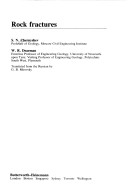This is a book for practitioners and postgraduate students in engineering geology, geotechnical, and civil and structural engineering. It's aim is to describe fractures from both practical and theoretical standpoints to use fracture data to solve problems in geomechanics, seismology and structural geology. Existing theories of fracture patterns are drawn together to produce a general geological theory fracture, whose use has been validated by investigations carried out during a number of mining projects. The main factor considered is the geometry of fracture sets. A detailed geological survey of fracture together with laboratory tests of rock samples and computer-aided processing of results, can produce reliable data on engineering properties of rock masses, essential for designers of mines, quarries and tunnels. The calculation method is applicable to anistropic rock masses, for which experimental geomechanical methods are of limited use. The use of fracture set models provides the solution to problems in structural geology, in particular determination of the position of concealed faults and fold axes.
Earthquake intensity can also be determined from fracture parameters, which provide impartial geological measurements of seismology as opposed to the less direct evidence provided by damage to building structures.
- ISBN10 0750610174
- ISBN13 9780750610179
- Publish Date 25 January 1991
- Publish Status Out of Print
- Out of Print 22 November 1993
- Publish Country GB
- Publisher Taylor & Francis Ltd
- Imprint Butterworth-Heinemann Ltd
- Format Hardcover
- Pages 282
- Language English
